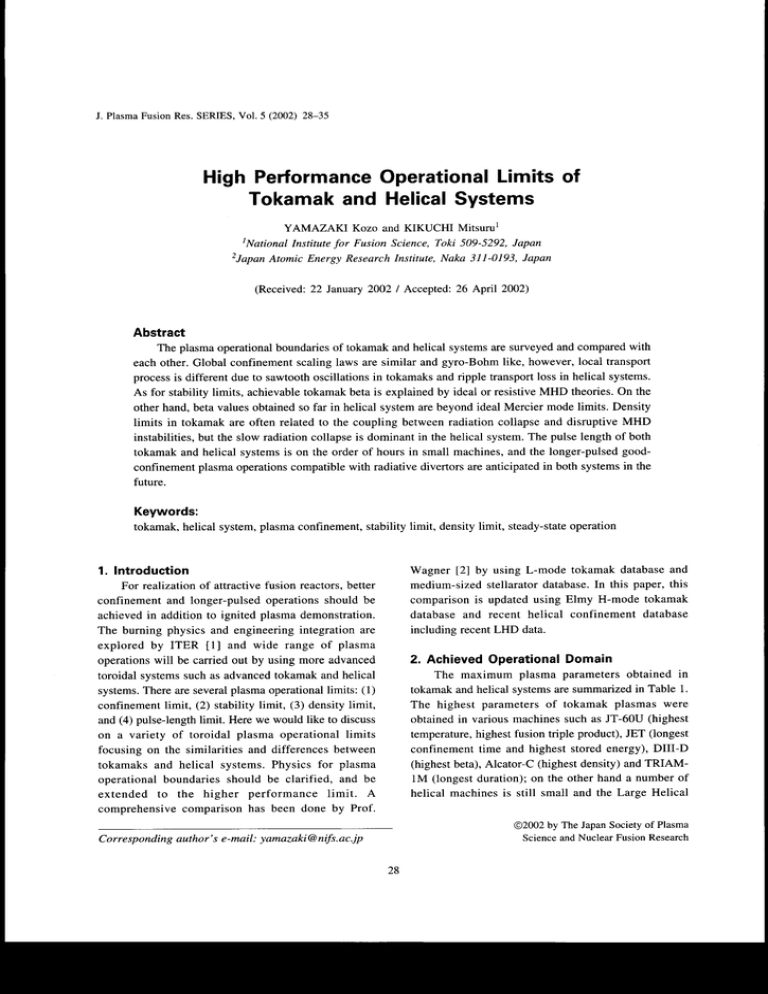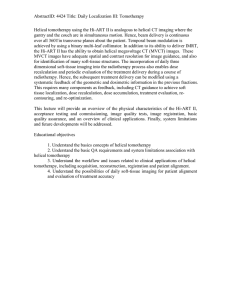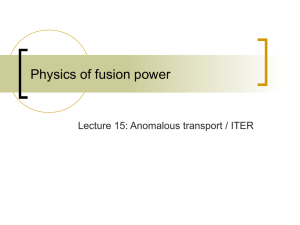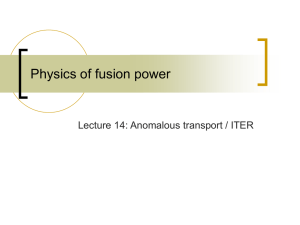High Performance Operational Limits of Tokamak and Helical Systems
advertisement

J. Plasma Fusion Res. SERIES,
Vol.5 (2002) 28-35
High Performance Operational Limits of
Tokamak and Helical Systems
YAMAZAKI Kozo and KIKUCHI Mitsurul
lNational Institute
for Fusion Science, Toki 509-5292, Japan
2Japan Atomic Energy Research Instiute, Naka 311-0193, Japan
(Received: 22 Jantary 2002
I
Accepted'. 26
April 2002)
Abstract
The plasma operational boundaries of tokamak and helical systems are surveyed and compared with
each other. Global confinement scaling laws are similar and gyro-Bohm like, however, local transport
process is different due to sawtooth oscillations in tokamaks and ripple transport loss in helical systems.
As for stability limits, achievable tokamak beta is explained by ideal or resistive MHD theories. On the
other hand, beta values obtained so far in helical system are beyond ideal Mercier mode limits. Density
limits in tokamak are often related to the coupling between radiation collapse and disruptive MHD
instabilities, but the slow radiation collapse is dominant in the helical system. The pulse length of both
tokamak and helical systems is on the order of hours in small machines, and the longer-pulsed goodconfinement plasma operations compatible with radiative divertors are anticipated in both systems in the
future.
Keywords:
tokamak, helical system, plasma confinement, stability limit, density limit, steady-state operation
Wagner [2] by using L-mode tokamak database and
medium-sized stellarator database. In this paper, this
comparison is updated using Elmy H-mode tokamak
database and recent helical confinement database
including recent LHD data.
1. lntroduction
For realization of attractive fusion reactors, better
confinement and longer-pulsed operations should be
achieved in addition to ignited plasma demonstration.
The burning physics and engineering integration are
[] and wide range of plasma
will be carried out by using more advanced
explored by ITER
operations
2. Achieved Operational Domain
The maximum plasma parameters obtained in
toroidal systems such as advanced tokamak and helical
systems. There are several plasma operational limits: (l)
confinemenr limit, (2) stability limit, (3) density limit,
and (4) pulse-length limit. Here we would like to discuss
tokamak and helical systems are summarized in Table 1.
The highest parameters of tokamak plasmas were
obtained in various machines such as JT-60U (highest
temperature, highest fusion triple product), JET (longest
on a variety of toroidal plasma operational limits
confinement time and highest stored energy), DIII-D
(highest beta), Alcator-C (highest density) and TRIAMlM (longest duration); on the other hand a number of
helical machines is still small and the Larse Helical
focusing on the similarities and differences between
tokamaks and helical systems. Physics for plasma
operational boundaries should be clarified, and be
extended
to the higher performance limit.
A
comprehensive comparison has been done by Prof.
@2O02by The Japan Society of Plasma
Science and Nuclear Fusion Research
Corresponding author's e-mail: yamazaki@ nifs.ac.jp
28
Yamazaki K. et al., High Performance Operational Limits of Tokamak and Helical Systems
Table 1 Maximum plasma parameters achieved in tokamak and helical systems.
TOKAMAK
(ASDEX-U,
JT-60U)
Electron Temperature
T" (keV)
25
lon Temperature
45
1.2
1.1
T, (keV)
Confinement time
re (s)
Fusion Triple Product
ni zE Ti (m-3.s. keV)
Stored Energy
we (MJ)
Beta Value
p(%l
Density
n" (1020m-3)
Plasma Duration
t a",
HELICAL
(LHD)
5.0
(LHD)
0.36
(LHD)
(JT-60U)
(JET)
(JT-60U, NS)
1020 (JT-60U)
(JET)
17
(JT-60U, NS)
11
40 (toroidal) (START)
12 (toroidal) (Dlll-D)
15
10
x
0.22
1O2o
(LHD)
(LHD)
1.0
3.0 (average) (LHD,W7-AS)
(Alcator-C)
20
min (Tore-Supra)
3 hr. 10min. (Triam-1 M)
2
TOKAMAK
x
2
3.6
(W7-AS)
min
(LHD)
(ATF)
t hour
HELICAL
TOK
. ASDEX
* AUG
x CMOD
s COMPASS
s D3D
^ JET
JFT2M
a JT60U
o PBXM
:! PDX
O TCV
B
STELL
6
x
g
6
a
B
a
"
."
v*
"
.
.
.
FFHR
HELE
HSR
LHD
MHR
SPPS
r: W7-AS
.001
.
".
CHS
.01
STELL
ASDEX
AUG
CMOD
*
x
CoMPASS
D30
JET
JFT2M
JT60U
PBXM
PDX
TCV
Vrr
CHS
O
FFHR
HELE
t,IHL
S
-
Oz
z
HSR
LHD
MHR
SPPS
,:: W7-AS
P*
P*
Fig. 1 Operational regimes and reactor requirements in tokamak and helical system.
Device (LHD) produces almost all highest parameters.
present, ttrere is still a parameter gap between
tokamaks and helical systems.
Not only absolute parameters, but also normalized
parameters are very important for the extrapolation of
the present database to the future reactor. Figure I
shows the operational domain for present machines and
tokamak reactor SSTR [3], LHD-type helical reactors
MHR [4], by using normalized parameters such as
normalized gyro-radius, plasma beta value and
At
collsionality:
p.=p"/a-^[T l@B),
29
F = nkT
l82-nT
v* = vela
/
v
t-
/ 82
na t
,
(es rz
f'z)
Yamazaki K. et al., High Performance Operational Limits of Tokamak and Helical Systems
The tokamak data used here are the Elmy H-mode data-
profiles make strong effect on the production of
base (IPB-DB3v5) [1] and data from JT-60U advanced
tokamak operation [5], and helical data are the medium-
confinement improvement modes. On the other hand, a
sized helical machine database [6] in addition to new
LHD data [4]. For extrapolation to the reactor, a few
factor reduction in p- is required for tokamaks; on the
other hand, the helical system should make access to the
one order of lower p- regime in the future. Even in the
present helical database the low collisionality regime for
reactors has been already explored.
produced by choosing helical coil systems. The q-profile
3. Equilibrium Properties
The standard tokamak is characterized by
variety of magnetic shear configurations can
is reversed or flat, and the magnetic hill region exists
near the plasma edge in the conventional helical system.
The divertor configurations strongly depend on the
plasma shape. The 2-dimentional tokamak system has
poloidal divertor with remote radiation. In helical
axi-
symmetric plasma shaping and external plasma current;
T il
1.5
the standard helical system is
3-dimensional
configuration and net-current-free operation. These
uj1
different plasma shapings give rise to different magnetic
confinement properties. Table 2 shows similarities and
differences between tokamak and helical systems.
Example of rotational transform for tokamak and
helical systems is shown in Fig. 2. In tokamak systems,
magnetic shear is easily modified by the plasma current
distribution, for example normal shear discharges and
JT. 0U
Nr
rmal
I
0.5
JT-601
0
Gurrer
Hole,
Fig.
2 Magnetic
shear for tokamak and helical systems.
Systems.
STANDARD TOKAMAK
CONVENTIONAL HELICAL
Plasma Boundary
Shape
2D
2D
Magnetic Field
Components
Toroidal (m,n) = (1,0)
Toroidal (1,0) + Helical
(L,M)+ Bumpy (0,M)
Divertor
Ripples
Poloidal divertor
No net toroidal current
or BS Current
Flat or
Reversed shear profile
Helical or island divertor
2D
3D
External + BS Currents
Normal or
Reversed shear profile
(B) Physics Properties
Magnetic shear
Maqnetic Well
Radial Electric Field
Toroidal Viscosity
grad-j, grad-p
lsland, Ergodicity
1
rho
(A) Magnetic Configuration and Equilibrium
q-profile
'\:.r
0 0.2 0.4 0.6 0.8
2 Similarities and Differences between Tokamak and Helical
Plasma Currents
/
hear
LH
current hole discharges in JT-60U [7]. These shear
Table
be
STANDARD TOKAMAK
Substantial Shear or
Shearless in the core
Well in whole region
driven by toroidal rotation
CONVENTIONAL HELICAL
& qrad-o
loss (Helical Ripple)
Large (Helical Ripple)
Small
grad-j driven
qrad-p drive
near separatrix
30
Substantial Shear
Hill near edge
driven by non ambipolar
grad-p dominant
Edge Ergodic Layer
Yamazaki K. et
al., High Performance Operational Limits of Tokamak and Helical Systems
magnetic layers give rise to differences in the
performance of plasma confinement.
These properties shown in Table 2 are described
mainly for standard tokamak and conventional helical
configurations. At present, various advanced plasma
shapings for helical systems are proposed as shown in
Fig. 3. Some of them are sorts of tokamak-helical hybrid
aiming at disruption-free steady-state operations.
systems, helical divertor concept with rather large
divertor space is adopted in LHD. In the design of
modular helical systems the island divertor concept is
explored and its effectiveness is demonstrated [8]. The
divertor and scrape off layer are related to ergodicity
and magnetic island, and differences
|-okamak
in
stochastic
tandard
Standard
-in,:mffif=r,,
4. Gonfinement
mf:\
:"
nii.rfrt.
L-ifh't
:;-- a! I'
il
^r
",i:l;;
o'-.,-,o*.*!D
The global plasma confinement scaling laws in
tokamak and helical plasmas are well established, Elmy
H-mode IPB98(y) [1] for tokamak and ISS95 for helical
.w
QP{FO
systems [6];
?fr-w = 0.0365R
U=5\
Au*lPololdll SFrndry
?lsses
QO
AuslOmunlgenlty
*
"=.()
p
-
0
63
-
0.41
o.o79a22tR06sP-ose
B
-
0'08
ltt
to.x
no"o
I
Qusl hllc.l SFmDby
3 Advanced 3-dimentional plasma shaping
TOKAMAK
HELICAL
TOK
ASDEX
AUG
CMOD
COMPASS
O D3D
STELL
.
*
x
o
a
{.
x
n
s
A
JET
JFT2M
D
;::
JT60U
PBXM
PDX
!
TCV
HELE
HSR
LHD
SPPS
W7-A
W7-AS
r';*
TOK
ASDEX
i
o
STELL
.
.
.
,
.
'
"
.
AUC
CMOD
COMPASS
D3D
JET
JFT2M
JT60U
PBXM
PDX
,::
O TCV
71S.t95
Fig.
CHS
FFHR
MHR
e
o
r
rtr*
.
f
x
*
9
5
e'7,
(
1
)
P,i.,B, €, t26 are major radius (unit: m),
minor radius (m), heating power (MW), line-averaged
density (l0te/m3), inverse aspect ratio, and rotational
transform at p = 213 in helical systems. These two scal-
Larger M
a
0
tll\ . Q)
Where R, a,
QH
Fig.
-
1 e3
1SS95
7uE
4 Confinement scaling laws for tokamak and helical systems.
3l
CHS
FFHR
HELE
HSR
LHD
MHR
SPPS
w7-AS
Yamazaki K. et al., High Performance Operational Limits of Tokamak and Helical Systems
ing laws are shown in Fig. 4 within solid frames. To
compare database of tokamak and helical systems, we
field shear is driven by toroidal rotation and pressure
gradient. On the other hand, in helical system, radial
used the simple formula of equivalent plasma current
with average minor radius auu for helical systems:
electric field is driven by ripple loss predicted by neoclassical transport theory. In the low density regime the
/"ou1u
-
u
-
aB,.
RB,
-\
neo-classical ITB near the plasma center was obtained
by the appearance of positive electric field in CHS [9].
The same phenomena have recently been observed in
{F;;fi"@)'a,(r)
n(m)r"lue)
LHD and the detailed physics will be clarified in
(3)
:- I _< o^,(*)'a,(r)
Ir,r- " R(m)I
5. Stability Limit
In tokamak systems ideal beta limits
"r",,(ro)
Figure 4 also shows a comparison between tokamak
confinement and helical confinement using rfiLMY and
zfse5. The tokamak data scaled by using both confine-
*
XB
?Lsse5
€
Tu p;0.1r
by
a - Fg"t
p^=___:___),,<3.5.
I
,/laB
,
mode, are restrictive in tokamak discharges. Figure 5
shows the agreement between experimental data and
theoretical analysis in JT-60U [1 1]. On the other hand,
in helical system pressure driven modes are dominant.
In the LHD experiment, achieved beta value is beyond
the Mercier local mode theory, while the global mode
analyzed by Terpschore code [12] is still marginal. The
unstable mode structure is rather broad in tokamak, on
the other hand. the localized mode is crucial in helical
system. The low-n mode has an interchange-like structure, and the high-n mode has a ballooning-like one.
but, local transport seems different. The standard tokamak confinement near the center is determined by
sawteeth oscillations, and helical core confinement is affected by helical ripple loss especially in the high temperature and low density regime.
The local transport, especially, the internal
transport barrier (ITB) looks different between tokamak
and helical systems. The tokamak has clear internal
transport barrier on electron and ion thermal transports
as obtained in JT-60U exoeriments. The radial electric
Equilibrium
4
z3
co-
....::::::.f
2
high-Bp mode
ry v
H-mode large po/<p>
0.2 0.4 0.6 0.8
- I.-r'''
Magnetic Axis Position (m)
eFp
Fig.
5 Stability Limits
(4)
,)
The pressure peaking effects on plasma stability are also
explained by the ideal MHD theory. Moreover, the resistive beta limits agree with neoclassical tearing mode
(NTM) or classical tearing mode (CTM) and resistive
wall mode (RWM). The kink-ballooning modes, which
are current driven mode coupled with pressure driven
p o83B-osuv;o 'o ,
B-u6V;o.M
agree with
ideal MHD theory, and global beta scaling law is given
ment laws seem better than the scaled medium-sized helical data, however, the LHD data stays on the ITER
Elmy H mode scaling using the above equivalent plasma
current. Globally, tokamak and helical transports look
similar and of gyro-Bohm type,
7!r-uv
the
future [10].
in tokamak and helical systems.
JZ
Yamazaki K. et
al., High Performance Operational Limits of Tokamak and Helical Systems
The current carrying toroidal plasmas are subject to
the existence of conducting wall. The global modes are
easily stabilized by the fitted wall. In helical systems,
the local mode is not linked to the wall, however, the
in this figure. The density limit of helical plasmas does
not seem to be related to the magnetic rotational transform, which is different from the tokamak density limits. The radiation collapse in tokamaks often gives rise
to plasma current quench; the helical high-density collapse leads to slow plasma decay.
To produce disruption-free tokamak discharges,
one of possible methods is to add external helical field
to tokamak plasmas. The complete suppression of major
disruption by applying external rotational transform I )
0.14 had been demonstrated in W7A tl5l and JIPP T-II
stellarator [16] twenty years ago. We should check
experimentally whether this method is effective even in
stability of bootstrap (BS) current-carrying helical
systems still depends on wall position.
6. Density Limit
The density limit is mainly related to thermal
power balance and the radiation collapse. In tokamaks
the plasma disruption is often related to the density
limits. The operational density regime is plotted by
using tokamak scaling (Greenwald scaling [13]) and
helical scaling (new scaling with modified coefficient
from the helical scaling [14]).
the BS driven tokamaks.
7. Steady-State Operation
h
zo-cp.=
. The longest pulsed operation is demonstrated in the
(s)
*2,
TRIAM-IM tokamak for 3 hours and l0minuts [7].
The long-pulsed higher performance discharges are
l, , ,
n2o_h"t=2'Minlv *8,
carried out in Tore-Supra. The reactor requirement in
steady-state tokamaks is to utilize BS currents and to
reduce the circulation power of the reactor plant. The
full non-inductive operation with 80 7o BS current
fractions and 20 Vo beam driven current has been
demonstrated in JT-60U [5].
_,;'
Figure 6 denotes the density domain of the transport database used in Figs. I and 4, not real density limits. This
helical scaling can roughly fit to tokamak data as shown
TOKAMAK
HELICAL
TOK
. ASDEX
t AUG
x cMoo
r COMPASS
a o3D
r JET
. Jfl2M
e JT60U
ler20
n
EXP
lerl9
C
PBXM
I
TCV
I e+21
STELL
. CHS
. HEE
"sD
1.+20
ft
axp
I.;,
IMA
=.+
I8{lm
lerl8
le+18
le+19
1d2O
l.+18
1e+21
tr^ cn
1e+20
l6+18
1e+21
GR
TOK
. ASDEX
I
I
STELL
t
r
r
x CMOD
. COMPASS
. D3D
A JET
. Jfl2M
5 JT60U
I
I
---t-----
:
TCV
I
fl
Fig.
16+20
lc+19
16+21
1.+20
h tno
rno
6 Operational density regime of tokamak and helical systems.
-t
-f
CHS
HEE
LHD
Yamazaki K. et al., High Performance Operational Limits of Tokamak and Helical Systems
In helical system, it is easy to keep its magnetic
economical reactors based on quasi-axisymmetric (QA)
configuration in steady state, and the remained issue is
to check compatibility between divertor and plasma
or quasi-poloidal (QP) configurations [18]. A lot of
common reactor engineering issues will be sheared
confinement.
between tokamak and helical desisns.
8. Reactor Prospect
9. Summary
As for reactor designs, one of critical issues for
both tokamak and helical systems is compatibility
Finally we can summarize the operational limits of
tokamak and helical plasmas in Table 3. The magnetic
configuration in tokamak system can be easily changed
between system compactness and remote maintenance
scheme. Especially, helical systems are supposed to be
by modifying plasma current distribution; in helical
rather large and not attractive from economical
systems various plasma shapings by adopting the helical
coil system give rise to a variety of magnetic properties.
Both global confinement properties are same such as
gyro-Bohm scaling. However, local transport is not
similar between tokamak and helical system, especially
radial electric field formation and internal transport
viewpoint. Figure 7 shows progress on reactor design
for making compact systems. Previous helical reactor
design has major radius of -20 meter, and now lowaspect-ratio designs with major radius of less than 10
meters are explored for the realization of compact and
barrier (ITB) properties. The plasma stability of
tokamak might be determined by MHD theory related to
current driven and pressure driven modes; in helical
system the pressure-driven mode is dominant and the
achieved pressure gradient is beyond Mercier mode
limits.
The realization of attractive fusion reactors, better
confinement and longer-pulsed operations should be
achieved, in addition to burning plasma physics
clarification that will be performed in ITER [1]. In
tokamak systems, critical issue is to avoid disruption
and to demonstrate steady-state operation; in helical
30
25
20
R(m)
10
systems high performance discharges should be
demonstrated with reliable divertor, and compact design
1970 1975 1980 1985 1990 1995 2000 2005 2010
Year
concepts should be explored. Each magnetic
confinement concepts should be developed
complementally focusing on above critical issues
keeping their own merits, for realization of attractive
Fig. 7 Progress on reactor design for making compact
and economical systems.
Table 3 Operational limits in tokamak and helical systems.
STANDARD TOKAMAK
Confinement
Beta Limit
Density Limit
Pulse-Length Limit
Beyond limit
Gyro-Bohm
Kink-Ballooning Mode
Resistive Wall Mode
Neoclassical Tearinq Mode
Radiation & MHD
Collapses
Recycling Control
Resistive Wall Mode
Neoclassical Tearinq Mode
Thermal collapse
Current quench
34
CONVENTIONAL HELICAL
Gyro-Bohm (Global)
Helical Ripple Effect
(Local)
Low-n Pressure-Driven Mode
Radiation Collapse
Recycling Control
Resistive mode (?)
Thermal collapse
Yamazaki K. et
al., High
Performance Operational Limits of Tokamak and Helical Systems
reactors and for clarification of common toroidal plasma
confinement physics.
16l U. Stroth e/ a/., Nucl. Fusion 36, 1063
References
[]
ITER Physics Basis Editors et al.,Nlcl. Fusion 39,
[2]
2137 (1999).
F. Wagner, Plasma Phys. Control. Fusion 39, A23
(1997\.
t12l A. Cooper, private communication.
ll3l M. Greenwald et a/., Nucl. Fusion 2E,2199 (1988).
ll4l S. Sudo et al.,Ntcl. Fusion 30, ll (1990).
ll5l WV[- A Team, Nucl. Fusion 20,1093 (1980).
[3] Y. Seki, M. Kikuchi er al.. I3'h IAEA Conf. Plasma
Physics and Controlled Nuclear Fusion Research
(Washington, 1990) IAEA-CN-53/G-1-2 (1991).
t4l
t16l J. Fujita et al., IEEE Transaction on Plasma
K.Yamazaki et al., l8'h IAEA Conf. Fusion Energy
C o nfe r e nc e IAEA-CN-77 tFTP2l 12 (Sorrento, Italy,
Science PS-9, 180 (1981).
[17] M. Sakamoto et al., this Conference.
[18] J.F. Lyon et al., l8'n IAEA Conf. Fusion Energy
C onfe re nc e IAEA-CN-77 tFTP2l | 8 (Sorrento, Italy,
4-10 October 2000).
t5l M. Kikuchi
(1996).
[7] T. Fujita et al., this conference.
[8] P. Grigull, this conference.
t9l A.Fujisawa et al.,Phy. Rev. Lett. 82,2669 (1999).
[0] K.Yamazaki et al., this conference.
I I ll S. Takeji. private communication.
and the JT-60 Team, Plasma Phys.
Control. Iiusion 43, A2l7 (2001).
4-10 October 2000).
35





